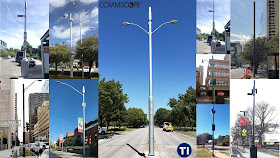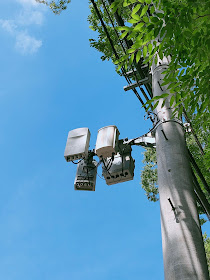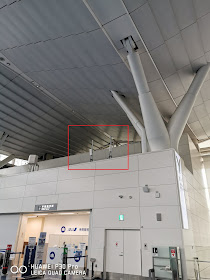If you are a regular reader of this blog then you will know we love lamp posts, street lights and poles. There are quite a few posts whose references you can find at the end of this post.
The mmWave Networks group at Telecom Infra Project (TIP) have recently released a new whitepaper, Leveraging Streetlights for the Digital Future. Street fixtures like lamp posts, light poles, traffic signals and other vertically-oriented assets that provide line of sight to targeted facilities and residential areas were identified as having a huge potential for rapid deployment of high speed future broadband networks (including 5G) in the TIP Playbook for Smart Cities.
This new whitepaper looks at "Deployment of high capacity urban mobile networks and smart city applications converges on assets in the public space, such as streetlights. This study and analysis deepens the understanding of the obstacles to deploying on streetlights today and points to possible pathways to accessing such assets to enable fast and flexible deployments"
Quoting from the whitepaper:
In a Digital Networks Working Group handbook by the Federal Ministry of Transport and Digital Infrastructure (Germany), streetlighting infrastructure has been identified as being very suitable in comparison to other street fixtures.
Deutsche Telekom initiated a study to explore such fixtures and possible pathways to accessing them. Before tackling any challenges, we wanted to understand what the "landscape of the players' ecosystem" looks like, what drives it, what slows it down or stops it from moving, how it works today, and what may need to change.
We did this specifically for our German home market, but feel confident that the study results can serve as pointers for the challenges and opportunities this asset poses for many other markets. We also believe the political and legal challenges will be very similar for similar assets apart from streetlights.
The study set out to describe the rules and regulations of public administration, public economy, and public law to which this infrastructure is subject, as well as to identify challenges, opportunities, and potential for its future design.
We chose a design thinking approach because we need to understand the players and stakeholders who control this infrastructure. And we wanted to undertake this before assessing what can and should be done with these potential assets to enable comprehensive broadband coverage and smart city development.
The whitepaper is available here.
Related Posts:
The mmWave Networks group at Telecom Infra Project (TIP) have recently released a new whitepaper, Leveraging Streetlights for the Digital Future. Street fixtures like lamp posts, light poles, traffic signals and other vertically-oriented assets that provide line of sight to targeted facilities and residential areas were identified as having a huge potential for rapid deployment of high speed future broadband networks (including 5G) in the TIP Playbook for Smart Cities.
We explored drivers, barriers and opportunities for the digital future for leveraging #streetlights based on interviews with experts from the ecosystem with focus on GER. #UrbanConnectivity https://t.co/RHoOVBPxSE— Katja Henke (@cyberkaethe) August 21, 2020
This new whitepaper looks at "Deployment of high capacity urban mobile networks and smart city applications converges on assets in the public space, such as streetlights. This study and analysis deepens the understanding of the obstacles to deploying on streetlights today and points to possible pathways to accessing such assets to enable fast and flexible deployments"
Quoting from the whitepaper:
In a Digital Networks Working Group handbook by the Federal Ministry of Transport and Digital Infrastructure (Germany), streetlighting infrastructure has been identified as being very suitable in comparison to other street fixtures.
Deutsche Telekom initiated a study to explore such fixtures and possible pathways to accessing them. Before tackling any challenges, we wanted to understand what the "landscape of the players' ecosystem" looks like, what drives it, what slows it down or stops it from moving, how it works today, and what may need to change.
We did this specifically for our German home market, but feel confident that the study results can serve as pointers for the challenges and opportunities this asset poses for many other markets. We also believe the political and legal challenges will be very similar for similar assets apart from streetlights.
The study set out to describe the rules and regulations of public administration, public economy, and public law to which this infrastructure is subject, as well as to identify challenges, opportunities, and potential for its future design.
We chose a design thinking approach because we need to understand the players and stakeholders who control this infrastructure. And we wanted to undertake this before assessing what can and should be done with these potential assets to enable comprehensive broadband coverage and smart city development.
The whitepaper is available here.
Related Posts:
- The 3G4G Blog: 5G Integrated Access and Backhaul (IAB) Enhancements in Rel-17
- Telecoms Infrastructure Blog: NEC's 5G Antenna-equipped Smart Street Lighting to be Trialled in Tokyo
- Telecoms Infrastructure Blog: TIP Webinar on Open Optical & Packet Transport (OOPT)
- Telecoms Infrastructure Blog - 5G CrowdCell: World's First 5G OpenRAN Small Cell
- Telecoms Infrastructure Blog: Huawei's 5G Book RRUs Start Delivering On Their Promises
- Telecoms Infrastructure Blog: LuxTurrim5G smart light pole concept
- Telecoms Infrastructure Blog: Small Cells on Hong Kong Lamp Posts
- Telecoms Infrastructure Blog: 5G Small Cells on 'Smart Poles' in Denver
- Telecoms Infrastructure Blog: BSNL bringing 'Smart Telecom Poles' to India with help of Nokia
- Telecoms Infrastructure Blog: Ericsson's Invisible Sites: Urban Case Studies
- Telecoms Infrastructure Blog: ZTE's 4G / 5G Street Lights
- Telecoms Infrastructure Blog: KDDI to test 5G with base stations built in Street Lights
- Telecoms Infrastructure Blog: Vodafone UK improving coverage with Phone Boxes, Mini-masts & Manhole Covers











